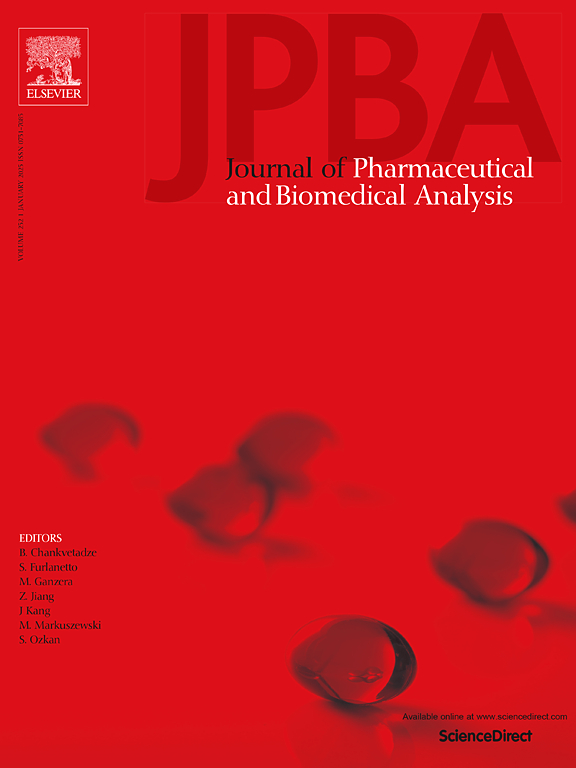Visualizing the spatial distribution of functional metabolites in the root of Codonopsis pilosula: An investigation integrating metabolomics, serum pharmacochemistry, and MALDI-MSI
IF 3.1
3区 医学
Q2 CHEMISTRY, ANALYTICAL
Journal of pharmaceutical and biomedical analysis
Pub Date : 2025-04-04
DOI:10.1016/j.jpba.2025.116873
引用次数: 0
Abstract
Codonopsis pilosula is a traditional Chinese tonic herb commonly used as food and medicine, particularly for the treatment of spleen deficiency syndrome. However, the specific bioactive components responsible for C. pilosula effects remain unclear, and their distribution in the root of C. pilosula has not been fully elucidated due to the lack of efficient analytical techniques. In this work, we combined metabolomics with serum pharmacochemistry to investigate C. pilosula effects in a rat model of spleen deficiency syndrome. Pearson correlative analysis was applied to discover that 8 chemical compounds, including lobetyolin, atractylenolide III, syringin, luteolin, asperuloside, O-acetyl-L-serine, L-citrulline and creatine, were significantly correlated with biomarkers and considered as potential pharmacodynamic basis of C. pilosula. Furthermore, matrix-assisted laser desorption/ionization mass spectrometry imaging (MALDI-MSI) was performed to visualize the spatial distribution of the bioactive substances in the root of C. pilosula. L-citrulline was widely distributed in roots. The content of atractylenolide III and luteolin in the cortex and xylem was much higher than that in the phloem. O-Acetyl-L-serine was present in the entire phloem and a small portion of the xylem. Creatine, lobetyolin, asperuloside, and syringin were mostly distributed in the peridermal cortex, and their contents were low. By integrating metabolomics, serum pharmacochemistry and MALDI-MSI, our proposed analytical method elucidated the material basis of C. pilosula and figured out their spatial distribution in the root of C. pilosula, which provides new insights for improving the quality of medicinal herbs.
可视化党参根部功能代谢物的空间分布:一项结合代谢组学、血清药物化学和MALDI-MSI的研究
党参是一种传统的中国滋补草药,常被用作食物和药物,特别是用于治疗脾虚证。然而,对党参作用的具体生物活性成分尚不清楚,由于缺乏有效的分析技术,其在党参根中的分布尚未完全阐明。本研究将代谢组学与血清药物化学相结合,探讨了党参对脾虚证大鼠模型的影响。Pearson相关分析发现,枇杷苷、白术内酯III、紫丁香苷、木犀草素、曲柄草苷、o -乙酰- l-丝氨酸、l-瓜氨酸和肌酸等8个化合物与生物标志物有显著相关性,可作为党参潜在的药效学基础。此外,采用基质辅助激光解吸/电离质谱成像技术(MALDI-MSI)对党参根中生物活性物质的空间分布进行了可视化研究。l -瓜氨酸在根中广泛分布。白术内酯和木犀草素在皮层和木质部的含量远高于韧皮部。o -乙酰- l-丝氨酸存在于整个韧皮部和木质部的一小部分。肌酸、枇杷苷、曲霉苷和丁香苷主要分布在表皮皮层,含量较低。结合代谢组学、血清药物化学和MALDI-MSI等方法,阐明了党参的物质基础,明确了其在党参根部的空间分布,为提高药材质量提供了新的思路。
本文章由计算机程序翻译,如有差异,请以英文原文为准。
求助全文
约1分钟内获得全文
求助全文
来源期刊
CiteScore
6.70
自引率
5.90%
发文量
588
审稿时长
37 days
期刊介绍:
This journal is an international medium directed towards the needs of academic, clinical, government and industrial analysis by publishing original research reports and critical reviews on pharmaceutical and biomedical analysis. It covers the interdisciplinary aspects of analysis in the pharmaceutical, biomedical and clinical sciences, including developments in analytical methodology, instrumentation, computation and interpretation. Submissions on novel applications focusing on drug purity and stability studies, pharmacokinetics, therapeutic monitoring, metabolic profiling; drug-related aspects of analytical biochemistry and forensic toxicology; quality assurance in the pharmaceutical industry are also welcome.
Studies from areas of well established and poorly selective methods, such as UV-VIS spectrophotometry (including derivative and multi-wavelength measurements), basic electroanalytical (potentiometric, polarographic and voltammetric) methods, fluorimetry, flow-injection analysis, etc. are accepted for publication in exceptional cases only, if a unique and substantial advantage over presently known systems is demonstrated. The same applies to the assay of simple drug formulations by any kind of methods and the determination of drugs in biological samples based merely on spiked samples. Drug purity/stability studies should contain information on the structure elucidation of the impurities/degradants.

 求助内容:
求助内容: 应助结果提醒方式:
应助结果提醒方式:


